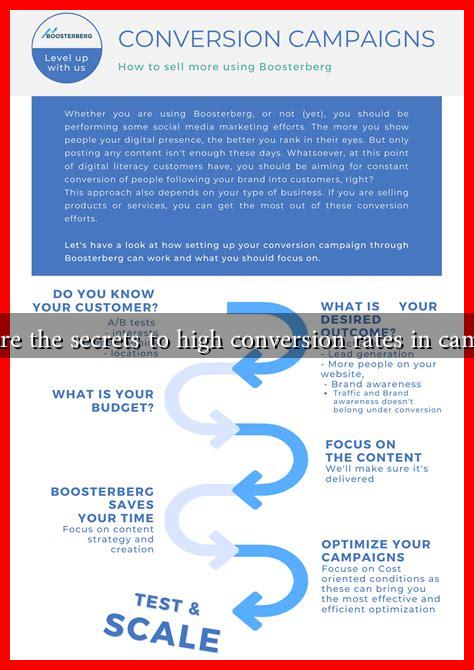-
Table of Contents
What are the Secrets to High Conversion Rates in Campaigns?
In the competitive landscape of digital marketing, achieving high conversion rates is a primary goal for businesses. A conversion rate is the percentage of users who take a desired action, such as making a purchase, signing up for a newsletter, or downloading an app. Understanding the secrets behind high conversion rates can significantly impact a campaign’s success. This article delves into effective strategies, backed by research and case studies, to help marketers optimize their campaigns for better results.
Understanding Your Audience
One of the foundational secrets to high conversion rates is a deep understanding of your target audience. Knowing who your customers are, what they want, and how they behave can inform every aspect of your campaign.
- Market Research: Conduct surveys, interviews, and focus groups to gather insights about your audience’s preferences and pain points.
- Segmentation: Divide your audience into segments based on demographics, behavior, or interests to tailor your messaging.
- Personas: Create detailed buyer personas that represent your ideal customers, helping you craft targeted content.
For example, a study by HubSpot found that personalized emails have a 29% higher open rate and a 41% higher click-through rate than generic emails. This highlights the importance of understanding your audience to create relevant content.
Crafting Compelling Copy
The words you use in your campaigns can make or break your conversion rates. Compelling copy not only grabs attention but also persuades users to take action.
- Clear Value Proposition: Clearly articulate what makes your product or service unique and why it matters to the customer.
- Emotional Appeal: Use storytelling techniques to connect with your audience on an emotional level, making your message more relatable.
- Strong Call-to-Action (CTA): Use action-oriented language in your CTAs, such as “Get Started Now” or “Claim Your Free Trial,” to encourage immediate action.
For instance, Dropbox’s early success can be attributed to its simple yet effective copy that emphasized the ease of file sharing and storage. Their CTA, “Sign up for free,” was straightforward and compelling, leading to high conversion rates.
Optimizing User Experience
A seamless user experience (UX) is crucial for converting visitors into customers. If users encounter obstacles while navigating your site or app, they are likely to abandon their journey.
- Responsive Design: Ensure your website is mobile-friendly, as over 50% of web traffic comes from mobile devices.
- Fast Load Times: Optimize your site to load quickly; a delay of just a few seconds can lead to significant drop-offs in conversions.
- Easy Navigation: Simplify your site’s layout and navigation to help users find what they need without frustration.
According to Google, 53% of mobile users will abandon a site that takes longer than three seconds to load. This statistic underscores the importance of optimizing user experience to enhance conversion rates.
Utilizing Social Proof
Social proof is a powerful psychological phenomenon where people look to others’ actions to determine their own. Incorporating social proof into your campaigns can significantly boost credibility and trust.
- Testimonials: Showcase customer reviews and testimonials prominently on your site to build trust.
- Case Studies: Share detailed case studies that highlight successful outcomes from using your product or service.
- Influencer Endorsements: Collaborate with influencers in your industry to reach a wider audience and enhance credibility.
A study by Nielsen found that 92% of consumers trust recommendations from friends and family over any other form of advertising. This highlights the effectiveness of social proof in driving conversions.
Testing and Iteration
Finally, continuous testing and iteration are essential for optimizing conversion rates. A/B testing allows marketers to compare different versions of a campaign to determine which performs better.
- Test Headlines: Experiment with different headlines to see which generates more clicks.
- CTA Variations: Try different CTAs to find the most effective wording and placement.
- Landing Page Designs: Test various landing page layouts to see which converts better.
For example, Optimizely, a leading A/B testing platform, reported that companies that regularly test their campaigns see conversion rate increases of up to 30%. This demonstrates the importance of data-driven decision-making in marketing.
Conclusion
Achieving high conversion rates in campaigns is not a matter of luck; it requires a strategic approach grounded in understanding your audience, crafting compelling copy, optimizing user experience, utilizing social proof, and continuously testing and iterating. By implementing these secrets, marketers can significantly enhance their campaign performance and drive better results. Remember, the key to success lies in being adaptable and responsive to your audience’s needs and preferences.
For further reading on improving conversion rates, check out HubSpot’s guide on improving conversion rates.

